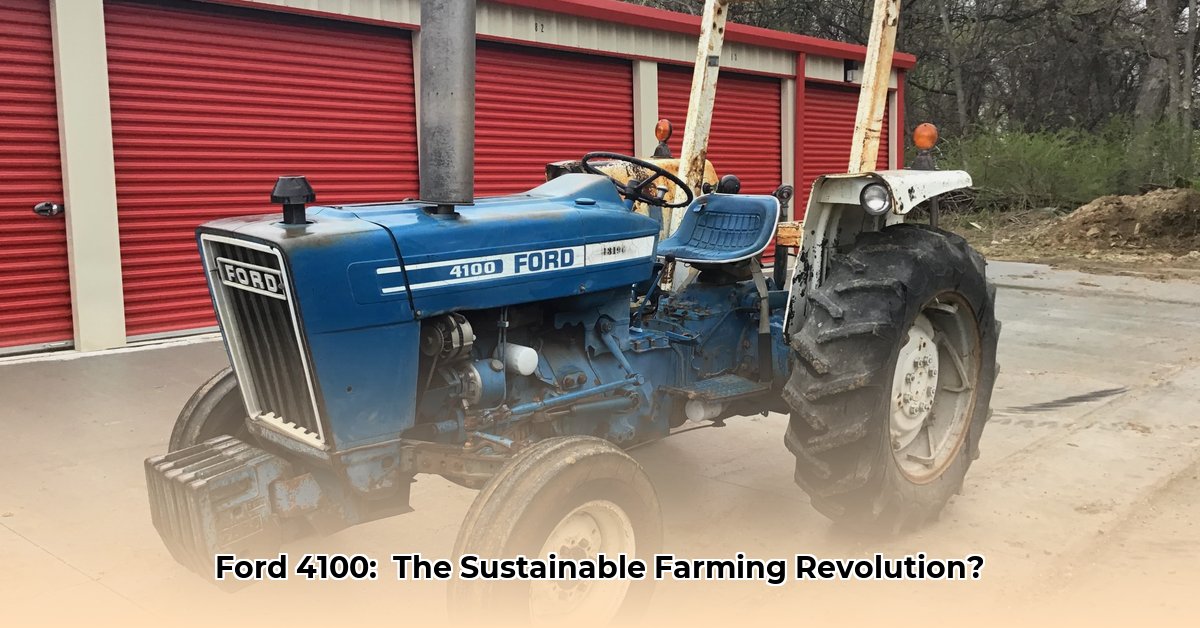
The Ford 4100 tractor, a stalwart of farms from 1975 to 1981, wasn't just a machine; it represented a significant chapter in agricultural technology and, surprisingly, holds relevance within the context of sustainable farming practices. This article explores its history, performance characteristics, and its unexpected legacy in the evolution towards more environmentally conscious agriculture. For more detailed specifications, check out this Ford 4100 resource.
The Ford 4100: A Workhorse of its Time
The Ford 4100, powered by a robust 3-liter, 3-cylinder diesel engine, delivered a respectable 52 horsepower. Farmers relied on its capabilities for plowing, planting, and hauling. Its eight-speed transmission offered flexibility, and its 3080-pound rear lift capacity allowed for a diverse range of implements. Weighing approximately 4655 pounds, its relatively compact size provided maneuverability, a significant benefit for farmers with smaller fields or complex crop layouts.
How did this relatively simple machine compare to the sophisticated technology used in modern sustainable agriculture? Let's investigate.
Comparing the Ford 4100 to Modern Standards
While the Ford 4100's diesel engine was efficient for its era, it pales in comparison to modern fuel-efficient models. Today's tractors leverage precision farming technologies, including GPS guidance and advanced sensors, optimizing resource use and minimizing fuel consumption, fertilizer application, and water usage – features entirely absent in the 4100.
Another key difference lies in soil compaction. Modern sustainable practices prioritize minimizing soil compaction to improve soil health and water infiltration. While the 4100's weight wasn't excessive, modern tractors, particularly those with wider tires, significantly reduce compaction. Finally, the 4100’s 3080-pound lift capacity is dwarfed by the 5000+ pound capacity of many modern tractors, limiting its ability to use larger, more efficient modern implements. This impacts overall productivity and efficiency. Aren't these differences remarkable, considering the advancements in sustainable agricultural practices?
Sustainability in the 1970s and Beyond: The 4100's Unexpected Legacy
The Ford 4100's relevance to sustainable agriculture is largely historical. It represents a technological snapshot from before sustainability became a central agricultural goal. While farmers using the 4100 likely employed environmentally conscious practices like crop rotation, the tractor itself provided minimal direct support for these efforts. Its significance lies in showcasing the huge technological advancements that have driven the evolution towards more sustainable farming methods.
What was the farmer's experience with using this technology, and how did it compare to today’s tools?
Farmers' Perspectives: Then and Now
For contemporary farmers, the Ford 4100 often evokes nostalgia, a reminder of the substantial progress in agricultural technology. Many appreciate its reliability and simplicity but acknowledge its limitations compared to modern equipment. The experience of using both highlights the significant strides towards efficiency and reduced environmental impact.
A Legacy of Innovation
Despite its limitations by today's standards, the Ford 4100 played a crucial role in shaping the foundation for modern sustainable farming practices. The tractor stands as a testament to the evolution of our understanding of sustainability and how technology continuously supports eco-friendly farming. The transition from the 4100 to modern sustainable tractors signifies a significant leap in agricultural efficiency and environmental responsibility. This improvement directly benefits the environment; wouldn't you agree?
Specifications Comparison: Ford 4100 vs. Modern Sustainable Tractor
| Feature | Ford 4100 Tractor | Modern Sustainable Tractor |
|---|---|---|
| Engine Horsepower (hp) | 52 | 75-150+ |
| Engine Type | 3-cylinder Diesel | 4-cylinder Diesel/Hybrid/Electric |
| Fuel Efficiency | Relatively Low | Significantly Higher |
| Precision Farming | None | GPS Guidance, Auto-Steer |
| Emission Standards | None | Tier 4/5 compliant |
| Lift Capacity (lbs) | 3080 | 5000+ |
Note: This is a general comparison. Specific modern tractor specifications vary considerably.
The Ford 4100's Subtle Influence on Sustainable Practices in the 1970s
While not explicitly designed for sustainability, the Ford 4100's characteristics subtly contributed to environmentally conscious farming. Its relatively smaller size and various engine options allowed for optimized fuel consumption and reduced environmental impact. Furthermore, its lighter weight, compared to heavier tractors of the era, resulted in less soil compaction—a key aspect of modern sustainable agriculture. The tractor's longevity also minimized the need for frequent replacements, advocating for a more sustainable approach to equipment use.
Key Takeaways:
- The Ford 4100's versatility optimized fuel consumption on smaller plots.
- Engine size options allowed farmers to balance power and fuel efficiency.
- Lighter weight minimized soil compaction, promoting soil health.
- Longevity reduced the need for frequent replacements, reflecting sustainable practices.
The Ford 4100’s story exemplifies the evolving relationship between technology and the environment in agriculture. While not a perfect paradigm of sustainable machinery, it represents a significant step in the journey towards eco-conscious farming.